Animism is the view that human beings on the earth live — whether they know it or not — in community with persons who are not human beings. These other-than-human persons may include animals, plants, trees, rocks, clouds, thunder, and stars. The phrase other-than-human persons was coined by anthropologist Irving Hallowell to describe the world of the Ojibwe, in which humans, animals, fish, birds, and plants — and some rocks, trees, and storms — are all relational, intentional, conscious, and communicative beings. Ethnographer Thomas Blackburn reached similar conclusions for the Chumash Indians, whose cosmos, he said, is composed of an “interacting community of sentient creatures.”
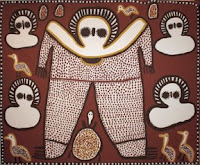 |
Other-than-human persons may be helpful, harmful, callous, malicious, indifferent, or tricky, just like human persons. It is often helpful or necessary to enter into personal relationships with them; such relationships with other-than-human persons may be comforting, demanding, or dangerous, just as with human persons. As a result of such relationships, other-than-human persons may provide information, insight, power, vision, healing, protection, songs, and ceremonies. The receipt of such gifts entails reciprocal obligations, just as with human persons.
And we should not read the phrase other-than-human as implying that humans constitute some standard of personhood to which others must aspire. Graham Harvey, a scholar of indigenous religions, points out that the phrase is used specifically for communication among humans; presumably chipmunks think of humans as other-than-chipmunk persons.
Animism is thus what anthropologist Nurit Bird-David has called a “relational epistemology.” Persons are recognized in a variety of ways, including whether they can be talked with, whether gifts can be exchanged with them, and whether they can be engaged in a cultural system of respect and reciprocity. Thus, human persons can give gifts to stone persons, who can receive those gifts, and give their own gifts to human persons in return. Anthropologist Enrique Salmón, himself a Tarahumara, calls this a kincentric ecology — “an awareness that life in any environment is viable only when humans view the life surrounding them as kin.”
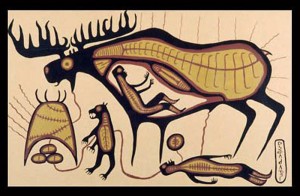 |
Recognizing such personhood is not indiscriminate. The Ojibwe, says Hallowell, “do not perceive stones, in general, as animate, any more than we do.” Rather, the stones who are persons have been seen to move or to manifest other animate qualities. Similarly, among the Saami, only certain stones, called sieidi, have hunger, emotions, or families; they are recognized to be persons because they have been observed to sing, for example, or move, or laugh, or shout.
As Harvey has pointed out, other-than-human persons do not have to look or speak like human persons to be recognized. Other-than-human persons “have their own ways of communicating,” he told an interviewer, “and a large part of animism may be finding the appropriate way to communicate, to spend time with a tree and listen, and you can’t just go up to any old tree and expect it to engage with you. So the etiquette of animism is about spending time and listening, not about trying to project being human onto something which very clearly isn’t.”
This use of the term animism differs sufficiently from its earlier use that sometimes the term neoanimism is used instead. The term animism was coined by nineteenth-century anthropologist Edward Tylor to define the essence of religion as “the belief in spirits” — that is, as a category mistake made by young children and primitives who project life onto inanimate objects, at least until they reach a more advanced stage of development. The more recent view, on the other hand, does not see animism as a set of beliefs so much as a way of engaging with the world. This engagement is based on relationships, within which humans are not separate from the world or distinct from other beings in any meaningful way. Indeed, for some humans — certain clans, for example — the mutual relationship with a particular other-than-human person, sometimes called a totem, from the Ojibwe word dodem, can provide a significant focus for social and ritual life.
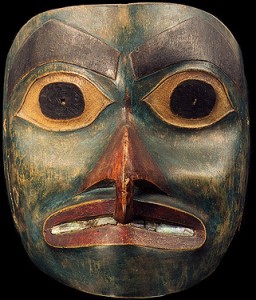 |
This engagement is often reflected in animist mythology, in which other-than-human persons were created before humans, at one time spoke with humans in a mutually intelligible language, and, indeed, appeared in the form of humans. In some cultures, other-than-human persons are believed to see themselves in human form, and thus as self-aware of their own personhood.
Harvey is one of the most eloquent current defenders of the neoanimist world view, both in his book Animism: Respecting the Living World and in his Animist Manifesto. Harvey draws the ecological and ethical conclusions inherent in “ontologies and epistemologies in which life is encountered in a wide community of persons only some of whom are human.” The new animism, he says, “contests modernist preconceptions and invites the widening of relational engagements generated and enhanced by gift exchanges and other forms of mutuality. Animism, he says, “encourages humans to see the world as a diverse community of living persons worthy of particular kinds of respect.” As he puts it — pointedly — in his Manifesto:
Since all that exists lives — and since all that lives is, in some senses, to some degree, conscious, communicative and relational — and since many of the persons with whom we humans share this planet have a far better idea of what’s going on than we do — we can now stop all the silliness about being the pinnacle of creation, the highest achievement of evolution, the self-consciousness of the world or cosmos… We’re just part of the whole living community and we’ve got a lot to learn. Our job isn’t to save the planet, or speak for the animals, or evolve towards higher states. Many other-than-human people are already happily self-aware, thank you very much, and if we paid attention we might learn a few things ourselves.
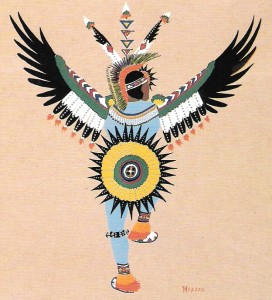 |
One of the most compelling recent works to put forward an animist worldview is The Spell of the Sensuous by David Abram. “We are human,” he writes, “only in contact, and conviviality, with what is not human.” Drawing on the perceptual phenomenology of Husserl and Merleau-Ponty, where he finds the roots of a participatory theory of perception, he argues for a return to an animistic vision of the natural world as a remedy to the radical separation from nature that emerged with Western civilization. He speaks of “the intuition that every form one perceives … is an experiencing form, an entity with its own predilections and sensations, albeit sensations that are very different from our own.”
Abram thus argues for an inclusive animism — one in which not only animals and plants are sentient and self-aware “but also the meandering river from which those animals drink, and the torrential monsoon rains, and the stone that fits neatly into the palm of the hand. The mountain, too, has its thoughts.” When indigenous cultures speak of spirits, he says, what they are really referring to are “those modes of intelligence or awareness that do not possess a human form” — that is, precisely, other-than-human persons.
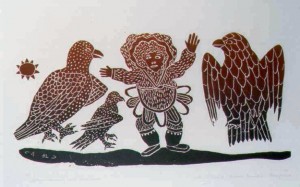 |
Interestingly, Abram conjectures that modern culture has lost its animism because of the emergence of the text. In the Phaedrus, Plato quotes Socrates as warning that writing “will introduce forgetfulness into the soul,” because people will come to trust in the static, written word, rather than “the words of an oak,” or a stone. When text replaces the world as the communicator of truth, then the text is treated animistically, as having its own voice, its own spirit. “The animating interplay of the senses has been transferred to another medium,” says Abram, “another locus of participation. It is the written text that provides this new locus. … The ‘inert’ letters on the page now speak to us. This is a form of animism … as mysterious as a talking stone. And indeed, it is only when a culture shifts its participation to these printed letters that the stones fall silent.”
As an alternative to being “hypnotized by a host of human-made technologies that only reflect us back to ourselves,” Abram proposes a return to animism. “Only by affirming the animateness of perceived things do we allow our words to emerge directly from the depths of our ongoing reciprocity with the world.” He quotes these Lakota words expressing reverence for a rock:
unmoved
from time without
end
you rest
there in the midst of the paths
in the midst of the winds
you rest
covered with the droppings of birds
grass growing from your feet
your head decked with the down of birds
you rest
in the midst of the winds
you wait
Aged one.
If you have ever slept in the comforting shelter of an aged and moss-covered rock, you will understand these words.
Now, all of this clearly relates to shamanism. Animism, in fact, is the form of life within which shamanism occurs — as Harvey puts it, which makes shamanism both possible and necessary. Shamans work within animist communities to maintain right relationships with the other-than-human persons on whom the community depends. These relationships must be maintained because humans need the gifts of other-than-human persons — their wisdom, power, and protection, and their bodies for our food. As Harvey puts it, in his typical way, “Respecting someone is no reason for not eating them.”
Three animist websites of interest are Animism, the companion website for Graham Harvey’s book by the same name; Wild Ethics, the website for David Abrams and his Alliance for Wild Ethics; and Bioregional Animism, which puts animism squarely in the context of place, where it belongs.

- Previous Post: The Theft of Voice
- Next Post: Joe Rogan on DMT
- More Articles Related to: Indigenous Culture, Shamanism



Well said and summed up my friend!
Have you read Harveys historical dictionary of shamanism? its fascinating what hes done with that… hes basically retold the history of shamanry from the point of view of new animism… its VERY clarifying!
I had never heard of Animism, until recently. It is encouraging to read something that makes sense, in terms of Spirituality
I am glad that you got something out of the post. Please feel free to wander around the blog, leave comments, and subscribe if you wish. You might also want to check out the outstanding website and blog on bioregional animism, both of which are filled with useful information and excellent readings. I wish you all the best on your journey.
I am glad you discovered it!
most people have only heard of shamanism… but its a misnomer honestly. there really is no shamanism persay but shamans within an animist culture.